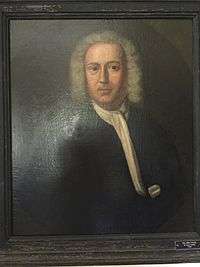John Tayloe I
| John Tayloe I | |
|---|---|
|
Portrait of John Tayloe I of the Old House | |
| Born |
February 15, 1688 Richmond Co, Virginia |
| Died |
November 15, 1747 (aged 59) Old House, Richmond County, Virginia |
| Resting place | Mount Airy, Richmond County, Virginia |
| Nationality | British/American |
| Occupation | Planter, Agent |
| Known for | Virginia Planter, Progenitor of the Tayloe's of Mount Airy |
John Tayloe I (February 15, 1688 – November 15, 1747) was one of the richest plantation owners and businessmen in Virginia for his generation. Considered to be the chief architect of the family fortune,[1] he was known as the "Hon. Colonel of the Old House".[2] The Tayloe family of Richmond County, including John Tayloe I, his son, John Tayloe II, and grandson, John Tayloe III, exemplified gentry entrepreneurship.[3]
Early years
His father was the Hon. William Taylor (1645–1710) of London, England who emigrated to the Colony of Virginia in the 17th century. He took up land in Lancaster and Richmond Counties in 1650. He was the progenitor of the Tayloe's of "Mount Airy." It is not known why his orthography was changed from Taylor to Tayloe. He accumulated a vast estate, and was a liberal supporter of the Established Church. He was a Burgess in 1710, 1728 and 1730.[2][4] In 1685, William married Anne (1664–1694), daughter of Hon. Henry Corbin (ca. 1629–1676) and Alice (Eltonhead) Corbin, of "Buckingham House", of Middlesex County.[5] His siblings included Elizabeth (b. 1686), and William (1694–1770).[6]
Career
Tayloe served as High Sheriff of Richmond County, 1713, and was an influential member of the King's Council, 1732.[2] A third-generation plantation owner from the Tayloe family of entrepreneurs, he operated the Neabsco Iron Works, which passed to his son, John Tayloe II in 1747 upon his death.[6] He was a member of Council in 1732 in Virginia.[7] Politically, Tayloe was well-connected which he used to exploit his business interests to their full potential. In 1738, he convinced the Governor's Council of Virginia to "relieve himself and other adventurers in Iron Mines from port duties on iron ore imported from Maryland."[6] He held over 320 slaves[1] on the Northern Neck and in the Rappahannock River area, tending tobacco and other crops, toiling in ironworks, or working around the home as domestics, gardeners, or carpenters.[8] He held large holdings in Charles County, Maryland, and in Essex and Prince William counties, Virginia.
He inherited the lands that comprised Mount Airy, although the house would be built by his son John Tayloe II, from his father William.[9]
Personal life
He married the widow Elizabeth (Gwynn) Lyde (1692–1734, daughter of David Gwyn and Katherine Griffin and resided at 'The Old House' in Richmond,[10] 2 miles from Mount Airy. The couple had four children: William Tayloe (1716–1726), who died at age 9, twins named John and Elizabeth (born 28 May 1721), and a daughter named Ann Corbin Tayloe, born 25 August 1723.[7]
References
- 1 2 McCusker, John J.; Morgan, Kenneth (2000). The early modern Atlantic economy. Cambridge University Press. pp. 347–. ISBN 978-0-521-78249-4. Retrieved 17 October 2011.
- 1 2 3 Hardy, Stella Pickett (1911). Colonial families of the Southern states of America: a history and genealogy of colonial families who settled in the colonies prior to the revolution (Now in the public domain. ed.). Wright. pp. 499–. Retrieved 17 October 2011.
- ↑ "The Business History of the Virginia Gentry" (PDF). March 2008. Retrieved 19 October 2011.
|first1=missing|last1=in Authors list (help) - ↑ Tyler, Lyon Gardiner, ed. Encyclopedia of Virginia Biography. Volume 1. New York, Lewis Historical Publishing Company, 1915. OCLC 229136302. Retrieved February 16, 2013. p. 156.
- ↑ Lancaster, Robert Alexander (1915). Historic Virginia homes and churches (Now in the public domain. ed.). Lippincott. pp. 343–. Retrieved 17 October 2011.
- 1 2 3 Kamoie, Laura Croghan (2007). Irons in the fire: the business history of the Tayloe family and Virginia's gentry, 1700–1860. University of Virginia Press. pp. 62, 65, 183, 184–. ISBN 978-0-8139-2637-7. Retrieved 17 October 2011.
- 1 2 "Tayloe family". Rootsweb ancestry. Retrieved 14 October 2011.
- ↑ Wallenstein, Peter (2007). Cradle of America: four centuries of Virginia history. University Press of Kansas. p. 152. ISBN 978-0-7006-1507-0. Retrieved 17 October 2011.
- ↑ McCue, George; American Institute of Architects Foundation (1976). The Octagon: being an account of a famous Washington residence, its great years, decline & restoration. American Institute of Architects Foundation. p. 9. Retrieved 17 October 2011.
- ↑ Valmarana, Mario Di; Center for Palladian Studies in America (Charlottesville, Va.) (1984). Building by the book. Published for the Center for Palladian Studies in America by the University Press of Virginia. p. 76. ISBN 978-0-8139-1022-2. Retrieved 17 October 2011.
